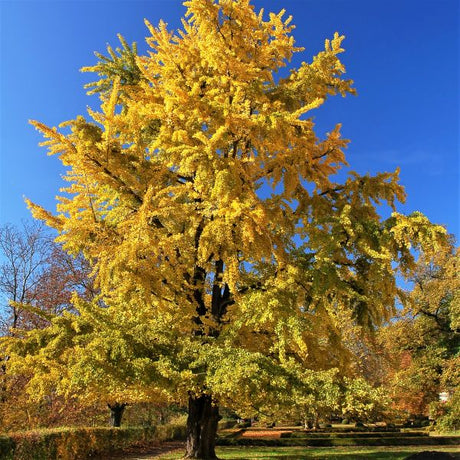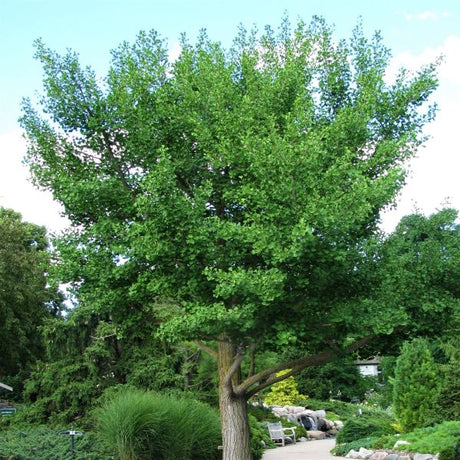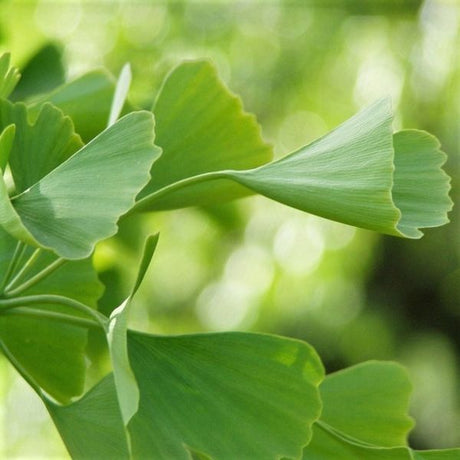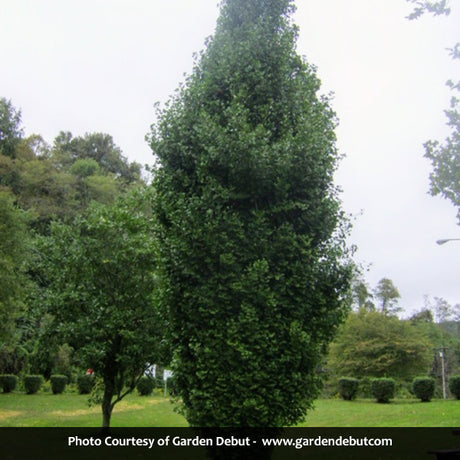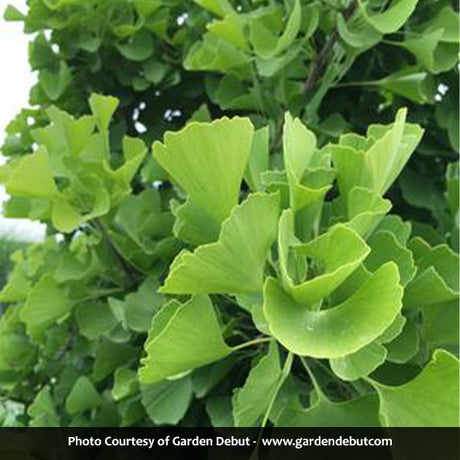Ginkgo biloba 'Princeton Sentry'
Regular price $8333Unit price /Unavailable- Sold out
- Sold out
- Sold out
Ginkgo Varieties for Sale at Nature Hills Nursery
Ginkgo trees (Ginkgo biloba) are survivors from prehistoric times, making them one of the most unique tree species available. These deciduous trees could be considered a 'living fossil' since the earliest Ginkgo leaf fossils date back from 270 million years ago.
You'll find several types of Ginkgo trees right here at Nature Hills Nursery, giving you a chance to own one of these exceptional beauties.
No other plants are genetically similar to the Ginkgo tree, although their beautiful leaves resemble Maidenhair fern. As a vibrant tree with fan-shaped leaves, their foliage stays bright green in summer, then turns a brilliant shade of gold in the fall.
Ginkgo leaves are designed to catch the wind. Long petioles help the fan-shaped leaves lift and sway in breezy weather.
You'll have a spectacular fall color show each year. It's even more jaw-dropping because the romantic golden foliage falls to the ground all at once, as if in concert.
Imagine getting out the rake only one time per year. Now that's a convenient shade tree.
There is rhyme to the syncopated rhythm of the Ginkgo tree's dramatic leaf drop. Each year, all the petioles develop their annual scar in response to cold weather.
Plan a party to celebrate this special event, or consider taking annual photos of your family under the Ginkgo tree on the fallen carpet of delectable color. Imagine a shade tree that is that easy to clean up.
Different Types of Ginkgo Trees
Sometimes called maidenhair trees, Ginkgo trees are long-lived, strong, and hardy enough to handle the forces of nature.
Ginkgo trees can withstand strong winds and grow in various soil types (including compacted soils). Full-grown Ginkgo trees are drought tolerant when fully established. Rugged Ginkgo also does well in urban environments.
Ginkgo biloba is grown from seed and tends to produce more female trees than male. Modern grafted cultivars produce whichever gender is desired.
For a fuss-free variety, buy the remarkably low-maintenance male cultivar Princeton Sentry Ginkgo tree for sale on our website. This is one of the most gorgeous Ginkgo varieties. It's also a very desirable clone of the male parent.
Princeton Sentry Ginkgo is not a female Ginkgo tree. This means there are no fruits or seeds.
As you can imagine, this is one of the most sought-after Ginkgo varieties for use as a shade tree. Buy this male Ginkgo tree from Nature Hills Nursery at any time of year, and we'll ship it to you when the time is right for planting in your area.
For the species, try our seed-grown Ginkgo biloba trees. You'll never worry about the deep tree roots of these magnificent urban-tolerant trees, as they will not lift pavement.
The Ginkgo tree has a long reproduction cycle. The Ginkgo flower may not appear on a female plant for 20 to 25 years.
Native to China, Ginkgo trees have been found that are over 1800 years old. They put up with wind, air pollution, tough sites, full sun and a wide range of hot, dry climates.
City planners love using the Ginkgo as street trees. If you find the golden-yellow Ginkgo leaf appealing, just wait! They are urban tolerant, somewhat salt tolerant, and have good resistance to disease and insect problems!
This fruitless male Ginkgo tree has some of the most spectacular fall color. It's also a snap to grow.
Design Ideas for Glamorous Ginkgo Trees
You'll leave a legacy for future generations, no matter which of the Ginkgo varieties you choose. Grace your neighborhood with its attractive foliage and robust nature.
The Sky Tower is a strongly columnar Ginkgo that turns into a glowing exclamation point in fall. Use this charming narrow tree in tight spaces, where the large Ginkgo biloba won't fit.
Sky Tower is another male clone that displays a vertical growth habit. Keep it as a lawn specimen in a mulched bed, or march a proud row of them along your front sidewalk.
Smaller male Troll Ginkgo trees make a very fun statement. Try them in a courtyard, or grow them in a large outdoor container for many years on your balcony.
Large Ginkgo trees for sale can be used to accent a corner of your property. Create a destination spot near a fire pit.
You'll be hard-pressed to determine which is brighter: the fire or the glowing Ginkgo leaf. In some years, the leaves grow to six inches long for a memorable landscape feature.
Ginkgo cultivars can be grown across the United States from growing zones 3 to 9. Nature Hills Nursery is excited to offer several Ginkgo biloba varieties to continue the tradition of these impeccable classics that fit beautifully into modern life.
Planting and Care Tips for Ginkgo Biloba Trees

Please read the Plant Highlights on every product page. You'll learn which USDA growing zones work best for different Ginkgo varieties, along with sun exposure and soil type requirements.
For the most part, Ginkgo trees flourish in well-drained soil with a pH of 5 to 5.5. They thrive in full sun to partial shade, and they are blissfully easy to maintain.
Track your package right to your doorstep. To get them fully hydrated, soak your new Ginkgo trees underwater until the air bubbles stop coming to the surface.
Dig your planting hole twice as wide as the roots, but no deeper. We highly encourage using Nature Hills Root Booster as a symbiotic support for feeder roots that remain active for the tree's entire life.
Decide which direction the tree will face your home before you remove it from the container. Tap your Ginkgo tree out of its garden container, and settle it in the planting hole.
Firm the backfill soil, then saturate the ground around your new tree to eliminate air pockets at the root zone. Taking time during planting makes all the difference to young trees.
Learn How to Water New Plants the Right Way
Mulch over the root zone to a depth of 3 feet. Spread the mulch to 3 feet outside the canopy, then pull it back away from the main trunk.
Fertilize your Ginkgo tree with a good slow-release fertilizer. Please follow the application rates on the package.
Pruning is generally not required. Remove broken limbs as needed in late winter or early spring.
Go ahead and make a tremendous visual impact on your landscape. Review the types of Ginkgo trees we have available, and then pick the one that works best for you.
Count on the beauty and durability of ancient Ginkgo trees, expertly grown by Nature Hills Nursery. Place your order today.
FAQ's for Buying Ginkgo Trees Online
Are Ginkgo trees good shade trees?
Are Ginkgo trees good shade trees?
Yes, Ginkgo trees make excellent shade trees thanks to their broad, fan-shaped leaves and tall, upright structure. They provide lush summer canopy and a stunning golden leaf display in fall, with leaves dropping all at once for easy cleanup.
Do Ginkgo trees drop messy fruit?
Do Ginkgo trees drop messy fruit?
Only female Ginkgo trees produce fruit, which can be messy and pungent. For a low-maintenance option, plant a male cultivar like Princeton Sentry or Sky Tower Ginkgo, which do not produce fruit.
How fast do Ginkgo trees grow?
How fast do Ginkgo trees grow?
Ginkgo trees grow at a moderate rate, averaging 12–24 inches per year depending on conditions. They establish deep roots, are long-lived, and gradually become large, low-maintenance landscape trees over time.
Where is the best place to plant a Ginkgo tree?
Where is the best place to plant a Ginkgo tree?
Plant Ginkgo trees in full sun to partial shade and in well-drained soil. They are incredibly hardy and tolerate compacted soil, urban pollution, salt, and drought once established—ideal for city streets, front yards, and large open spaces.
Are Ginkgo trees deer resistant and disease tolerant?
Are Ginkgo trees deer resistant and disease tolerant?
Yes, Ginkgo trees are both deer-resistant and highly disease and pest tolerant. Their resilience makes them one of the most carefree and durable trees for home landscapes and urban environments.






